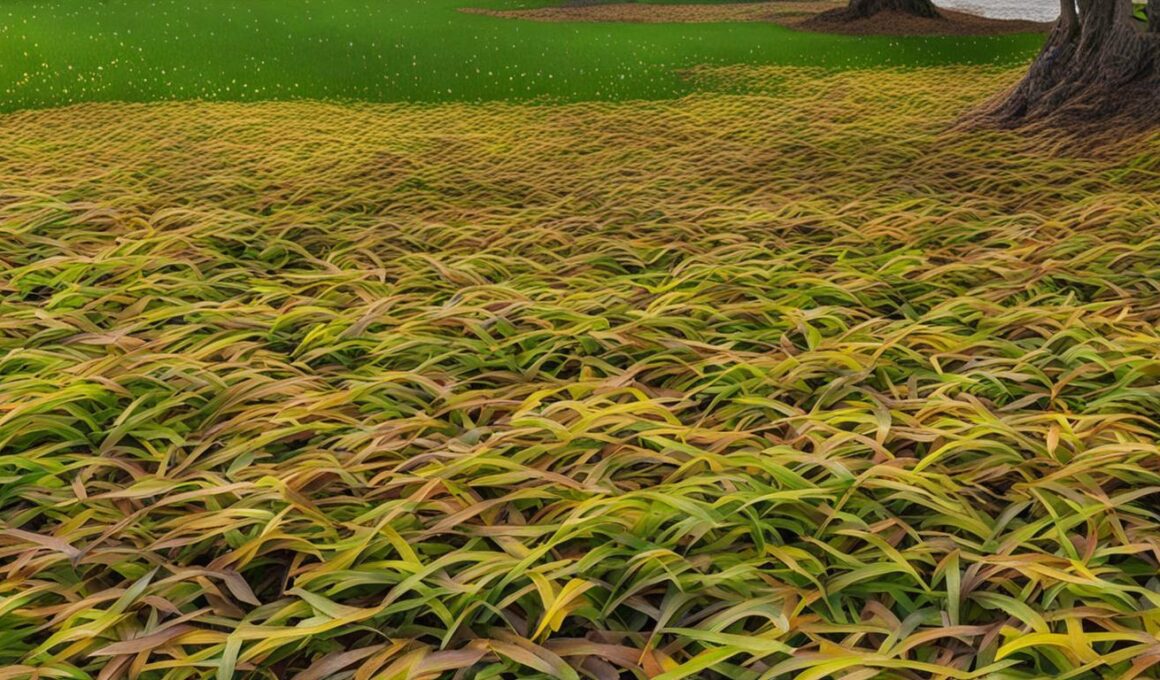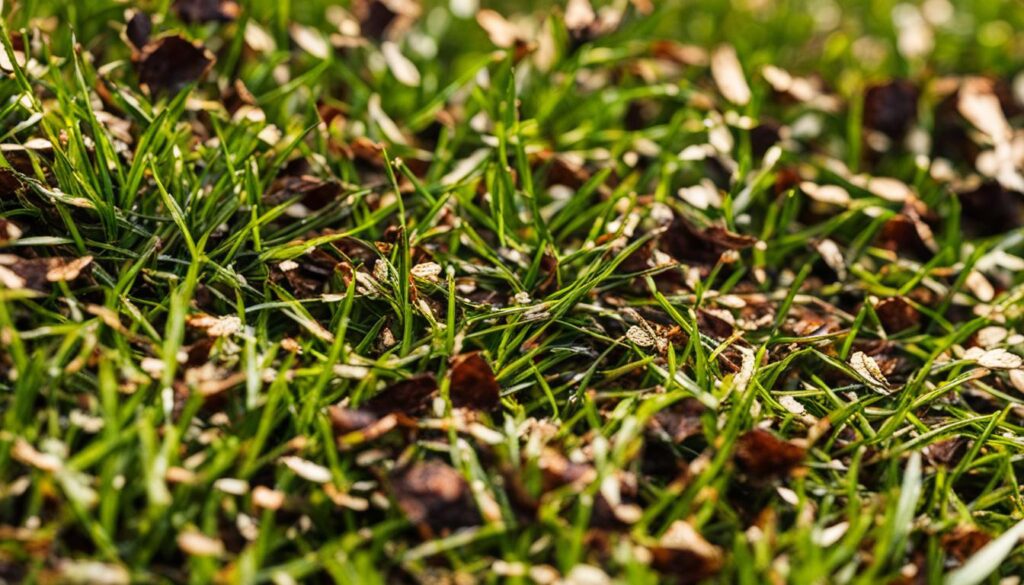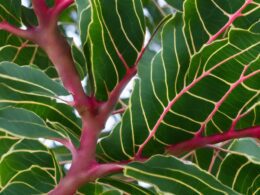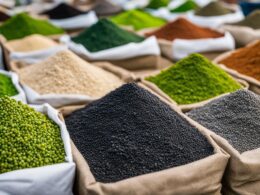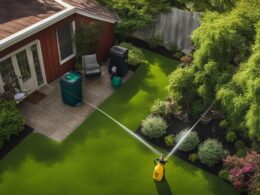Zoysia grass is a versatile and popular choice for lawns due to its ability to adapt to different climates and soil types. However, like any grass, zoysia is susceptible to various problems that can affect its health and appearance. In this section, we will explore some of the most common zoysia grass problems, including diseases and pests, and provide tips for prevention and treatment.
Common Diseases of Zoysia Grass
Zoysia grass is a beautiful and resilient turfgrass that can enhance the aesthetics of any lawn. However, it is not immune to diseases that can impact its health and appearance. It’s important to be aware of the common zoysia grass diseases and understand how to identify and manage them effectively.
Brown Patch
One of the most prevalent diseases that affects zoysia grass is brown patch. This disease is characterized by circular patches of dead and discolored grass with a brownish hue. High humidity and cool temperatures create ideal conditions for the development of brown patch. Proper watering techniques, avoiding excessive nitrogen fertilization, and improving air circulation can help prevent and manage this disease.
Rust
Rust is another common disease that can affect zoysia grass. It presents as orange or yellowish rust-like spores on the grass blades, giving them a rusty appearance. Rust tends to occur in areas with poor drainage and low nitrogen levels. Regular mowing, proper fertilization, and improving soil drainage can help prevent and control rust infestations.
Fusarium Blight
Fusarium blight is a fungal disease that affects zoysia grass during hot and humid weather conditions. It causes irregular patches of brown or yellow grass that may appear water-soaked. Over-fertilization, excessive thatch, and poor soil drainage can contribute to the development of fusarium blight. Implementing proper lawn care practices and using fungicides when necessary can help manage this disease.
Crown Rot
Crown rot is a destructive disease that attacks the crown and root system of zoysia grass, leading to yellowing, thinning, and stunted growth. Excessive thatch accumulation, poor soil drainage, and over-watering can create an environment conducive to crown rot. Regular dethatching, adequate soil drainage, and proper watering techniques can help prevent and control crown rot.
Leaf Spot Disorder
Leaf spot disorder is characterized by small, dark spots on the grass blades of zoysia grass. It is caused by various fungal pathogens and tends to occur in humid and damp conditions. Proper lawn maintenance, including regular mowing, proper watering, and maintaining adequate air circulation, can help prevent and manage leaf spot disorder.
Dollar Spot
Dollar spot is a common disease that affects many turfgrass species, including zoysia grass. It is identified by small, silver dollar-sized spots on the grass blades, eventually leading to straw-colored patches. Dollar spot thrives in areas with low nitrogen levels and high humidity. Adequate watering, proper fertilization, and regular mowing can help prevent and control dollar spot outbreaks.
By familiarizing yourself with these common zoysia grass diseases and implementing proper lawn care practices, you can maintain a healthy and disease-free zoysia grass lawn. Remember to regularly monitor your lawn for any signs of disease and take appropriate measures to prevent and manage them effectively.
Common Pests Affecting Zoysia Grass
Zoysia grass, while resilient, is also prone to pest damage. Among the most common culprits are chinch bugs and hunting billbugs. Chinch bugs feed on the grass blades, causing them to wilt and turn brown. On the other hand, hunting billbugs attack the lower leaf stems and stolons, leading to yellowing and thinning of the grass.
Aside from chinch bugs and hunting billbugs, other pests can also wreak havoc on zoysia grass, including moles, mice, gophers, and rabbits. These pests can cause significant damage to your lawn if left unaddressed.
Identifying and dealing with pest infestations promptly is crucial to prevent further damage to your zoysia grass. You can implement integrated pest management techniques, such as using insecticides, to control pest populations effectively. Additionally, practicing proper lawn maintenance, such as regular mowing, watering, and aerating, can help preserve the health of your zoysia grass and reduce the risk of pest infestations.
Tips for Maintaining a Healthy Zoysia Grass Lawn
Proper maintenance is key to keeping your zoysia grass lawn healthy and vibrant. By following these tips, you can ensure the long-term health and beauty of your zoysia grass lawn:
Regular Watering
Watering your zoysia grass lawn regularly is crucial for maintaining its health. Aim to provide about 1 inch of water per week, either through rainfall or irrigation. Avoid over or under-watering, as both can lead to stress and damage to the grass.
Proper Fertilization
Fertilizing your zoysia grass lawn is essential to provide it with the nutrients it needs to thrive. Apply a slow-release fertilizer specifically formulated for zoysia grass according to the manufacturer’s instructions. This will promote healthy growth and help it withstand diseases and pests.
Mowing at the Appropriate Height
When mowing your zoysia grass lawn, it’s important to maintain the appropriate height. Set your mower to a height of 1 to 2 inches for a manicured look or 2.5 to 3 inches for a more natural appearance. Avoid cutting more than one-third of the grass height at a time to prevent stress and damage.
Implementing Preventive Measures
To protect your zoysia grass lawn against diseases and pests, it’s important to implement preventive measures. Regularly remove any thatch buildup to improve air circulation and reduce the risk of fungal diseases. Keep an eye out for signs of pests and take appropriate measures, such as using insecticides or natural predators, to control their population.
Promptly Addressing Issues
If you notice any issues with your zoysia grass lawn, such as poor drainage, compaction, or improper shade management, it’s important to address them promptly. Improve drainage by aerating the soil and removing any excess thatch. Reduce compaction by regularly aerating the lawn. Trim overhanging branches to allow sufficient sunlight to reach the grass.
By following these maintenance tips and establishing a regular lawn care routine, you can create a healthy and beautiful zoysia grass lawn that will be the envy of your neighbors.
How Can Slime Mold on Grass Impact Zoysia Grass and What Are the Common Problems Associated with It?
Slime mold on grass can impact Zoysia grass by causing discoloration and affecting the overall appearance of the lawn. Common problems associated with slime mold include unsightly patches and potential damage to the grass. However, there are effective slime mold prevention treatment options available to keep your grass healthy and thriving.
Conclusion
Zoysia grass is a versatile and resilient grass variety, capable of withstanding various challenges. However, it is not exempt from the problems that can arise, such as disease outbreaks, pest infestations, and improper maintenance. Recognizing the signs and causes of these issues is crucial in order to effectively address and prevent them, ensuring the health and beauty of your zoysia grass lawn.
By actively monitoring your lawn for disease symptoms, such as discoloration, wilting, or unusual growth patterns, you can catch potential problems early on. Implementing integrated pest management techniques, such as regular inspection and appropriate use of insecticides, can help control pest populations and minimize damage. It is also vital to practice proper lawn care, including regular watering, appropriate mowing height, and correct fertilization, to ensure the optimal growth and resilience of your zoysia grass.
Through proactive measures and regular maintenance, you can overcome common zoysia grass problems and enjoy a thriving lawn for years to come. By understanding the challenges that may arise and following the recommended practices, you can create an environment that promotes the health and lushness of your zoysia grass.
By employing a combination of education, vigilance, and proper care, you can maintain the vibrancy and beauty of your zoysia grass lawn, allowing you to relax and enjoy its benefits without worrying about potential issues that may arise. Take the necessary steps to protect your investment and create an inviting outdoor space that you can be proud of.





